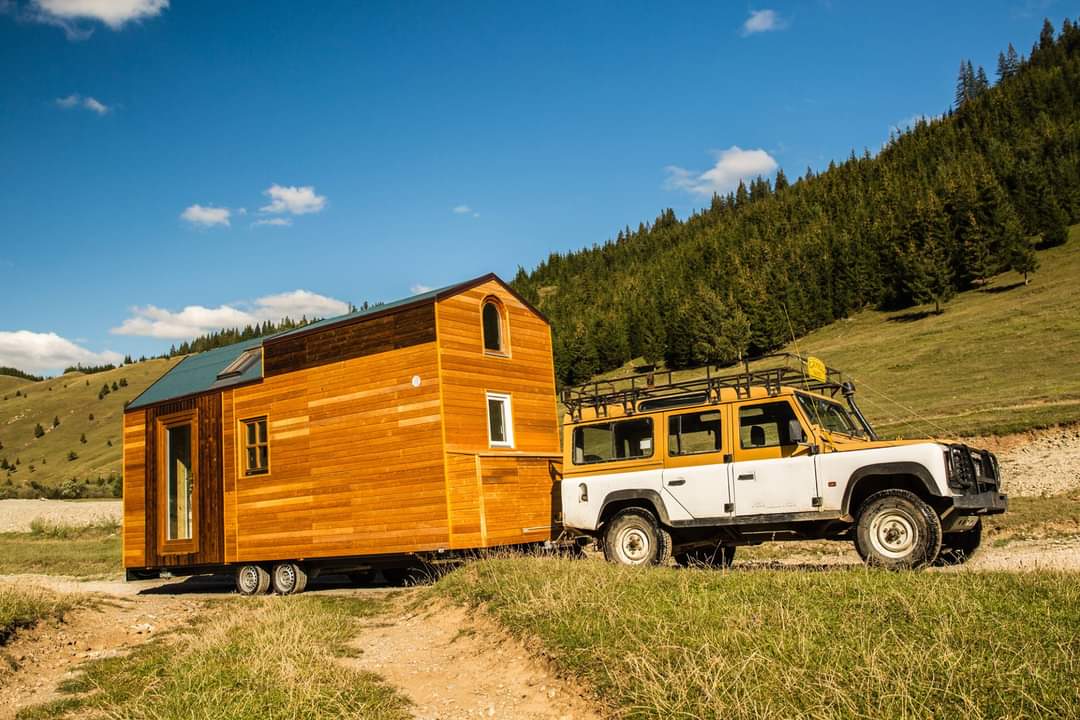2. What determined you to give up everything and start from scratch with a completely different lifestyle?
My biggest wish was to live in nature. To hear the rustle of the forest and to see the seasons dress and undress the trees. To hear birds. We can live in concrete, between walls, without seeing the sky, but it is much more beneficial to see the horizon line where the clouds kiss the top of the firs. So I wanted to be done with concrete and embrace Earth. I like animals since I can remember, I love being with them. I wanted to see my puppy running free in the grass, not waiting for 10 hours a day behind an apartment door for me to return from the office.
.jpg)
3. What are the costs of such a house?
It depends. A turnkey finished house can cost between 25 and more than 100,000 Euros. It depends on what materials you build it with, with whom. There are many variables. For a little house on wheels where you can stay both in winter and summer, there are some investments to be made. It's not just walls with a door. It is a construction in all respects, only in miniature. More special than a classic construction, because you have to choose materials and joints that favor its mobility.
4. Do you miss the hustle and bustle of city life, or would you never go back to your previous lifestyle?
Would I go back? No. No. No. You can't go back to the city after you've been in nature. It's like falling from the sky. For me, at least. Yes, I come to the city often, Sibiu is wonderful and always offers you new adventures and I am glad to be able to come to a cafe to watch the hustle and bustle or to participate in an event with new people. I like the interaction. But nothing compares to what I feel when I drive home. To my garden in Gura Raului.
5. Tell us about the Atlas of Joy, what it is and what the purpose of the project is.
(1).jpg)
The Atlas of Joy is a photo-journalistic project about people's joys. The question for everyone is: What makes you happy?
I started the Atlas of Joy because I am passionate about portrait photography and because I wanted to know if happiness depends on us or on external factors. So far I have stories from Portugal, Spain, France, Holland and many from Romania.
6. From your experience so far and from the stories of the people who participated in the Atlas of Joy project, what makes people happiest?
The most common answers are so simple: love, my family, loved ones. No one has told me so far that they are happy to have the most expensive car in the world, but it is true that I chose for interviews somewhat simple people, who are connected to the Universe. And that made me realize that happiness lies in simple things. In the good of those we love. An expensive car takes and brings you to and from somewhere, but it doesn't make you laugh, cry, it doesn't hold your hand, it doesn't hug you and it doesn't give your warm pancakes with a gentle look.
7. Tell us more about your projects and the activities you carry out.
Since I left the corporation and am a freelancer, I started to photograph more, to work with children, to draw, to write stories. Could I have done all this while working in an office with deadlines? No. Because I wasn't connected to my creative energy. I was in a world of numbers, of money, I was selling my time for money.
Ever since I wake up with the sun and see the trees in my garden I am calm and can do beautiful things, even if I don’t see the reward monthly on a pay stub.
What’s even nicer is that, once you are calm and radiate, you meet the right people or those who are looking for something similar and in these 3 years since I moved to the country, I have met so many fantastic people.
In conclusion, I’m going to whisper a secret to you: life in the country is not all rosy and with smell of rose water. It's with dirt under your nails and a lot of work, but it's amazing.
8. Finally, tell us where people interested in your projects can find you.
You can find children’s stories and more about the little house on wheels on my website: www.casutaplimbareata.ro.
Thank you very much and we wish you much success in future projects!
.jpg)

.jpg)
(1).jpg) The Atlas of Joy is a photo-journalistic project about people's joys. The question for everyone is: What makes you happy?
The Atlas of Joy is a photo-journalistic project about people's joys. The question for everyone is: What makes you happy?.jpg)
 52.89 sqm
52.89 sqm 2
2 100.3 sqm
100.3 sqm 3
3 104.56 sqm
104.56 sqm 4
4 55.54 sqm
55.54 sqm 2
2 53.55 sqm
53.55 sqm 2
2 100.4 sqm
100.4 sqm 3
3.jpg)
.png)